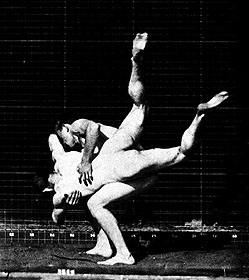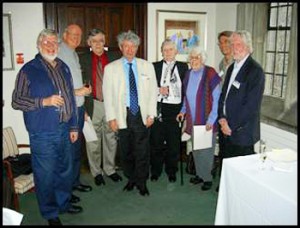1.Spring is Membership Renewal
2.The President’s Message
3.Call for Nominations
4.The VSAO 2007 Spring Conference
5.The Forum: “Realism, Regionalism, and the Discipline”
- “Hardy and Realism: A Backward Glance,” Michael Millgate
- “Fair Straight Lines,” Julia M. Wright
- “Hardy’s Wessex . . . ,” D.M.R. Bentley
6.Panels of Interest to Victorianists at the Upcoming Congress
7.The VSAO’s 40th Anniversary
As VSAO memberships run from 1 May to April 30, it is time to renew your membership dues. Please see the membership renewal form here.
Welcome to the new administrative year of the Victorian Studies Association of Ontario. As the new president of the VSAO, I must begin my term in office by thanking the past president, Dennis Denisoff , for his dedication to this organization over the past two years and his willingness to continue maintaining the website. I must also thank the members of the executive, David Latham (treasurer), Alison Halsall (secretary) and members at large, Stephen Heathorn and Christine Bolus-Reichert for their continued commitment.
In this issue of the newsletter, we are celebrating our 40th year while acknowledging some of the individuals present at our Spring Conference who were members during the VSAO’s first decade. My own association with the VSAO is a bit more recent, but rather longer than I had initially realized. It dates from the mid-1990s when, as a graduate student at McMaster University, I attended the annual spring conferences, thanks in large measure to Richard Rempel, professor emeritus of history at McMaster. Having now served as a member at large for a three-year term, I am very pleased to remain on the executive in a new capacity. I look forward to working with this scholarly community throughout Ontario to facilitate and support the study of all things Victorian.
During the summer months, the executive will be discussing themes and keynote speakers for next year’s annual conference, to be held in April 2008. Suggestions for speakers may be forwarded to the president or the members of the executive.
The number of VSAO-sponsored talks held at universities outside of Toronto is a sure indication of a very active and engaged membership. In 2007-2008, we will again host evening lectures both in and outside of Toronto . Information on these events will appear in the autumn newsletter, with updates appearing regularly on our website at www.ryerson.ca/vsao . In addition, please notify us of any events planned for the fall or winter that should be included in our September newsletter. Enjoy the summer.
Sincerely yours,
Anne
The Executive has a Member-at-Large vacancy, for which we will hold an electronic election. The position is a three-year term starting immediately and open to any current (2007-08) member of the VSAO. Duties include assisting with the general running of the association, and helping organize the Spring conference. The position requires no travel except to attend the conference (held in Toronto on the last Saturday in April) and to attend the annual executive meeting on the evening before the day of the conference. Please send any nominations by 1 June 2007 to Anne Clendinning at annec@nipissingu.ca .
The VSAO 2007 Spring Conference
Stephen Heathorn
The VSAO’s 40th anniversary conference was held at Victoria College on Saturday 28 April 2007. The theme of the conference was “Bodies in Motion” and consisted of a morning panel of three papers and two after-lunch keynote papers.
The morning programme featured Jaclyn Reid (Dept. of Communications and Art History, McGill University), “Sex for Sale: Mass Consumption of the Prostitute’s Body”; Constance Crompton (Programme in Communication and Culture, York University and Ryerson University),”‘We Admire Physical Strength and Beauty’: Eugene Sandow in the Public Eye”; and Jo Devereux (Dept. of English, University of Western Ontario), “Acting Lady Audley: The Female Body ‘On and Off the Stage,’ 1860-1890.” All three papers were well received and generated much discussion.
As usual, the Association held its annual business meeting during the conference lunch. Treasurer David Latham reported the steady state of the finances, but warned that conference costs were rising. President Dennis Denisoff , before handing the reigns of executive direction over to acclaimed incoming president Anne Clendinning, reported on the healthy state of the Association’s membership, and then addressed the potential financial drain of the annual conference. Noting that the costs of the annual conference had been subsidized by Ryerson University over the past two years – a situation not likely to continue – Dennis proposed that membership dues remain as they are, but that the conference fee be increased from $10 to $20. The rationale for this proposal was discussed and there was a consensus of those in attendance that, even at the increased rate, the conference was remarkably inexpensive. The motion was unanimously approved.
Following lunch, the assembled participants were treated to two excellent keynote addresses. Marta Braun ( School of Image Arts , Ryerson University ), presented a paper entitled “Photography, Darwin , and Victorian Anthropology.” Marta’s talk addressed how Darwinian evolutionary theory influenced nineteenth-century scientists’ use of photography, particularly that of the French physiologist Etienne-Jules Marey and the American photographer Eadweard Muybridge, two pioneers in locomotion photography.
Paul Deslandes (Department of History, University of Vermont ) then presented his lecture on “The Beautiful Man in Victorian and Edwardian Culture.” Paul’s paper explored how both physique and facial attributes were defined as attractive in Victorian writings of physiognomists, advertising gimmicks of beauty entrepreneurs, and illustrations in fitness and other magazines.
The two papers were remarkably complementary, and together addressed many of the important issues that were raised in the morning panel, such as the rise of commodity culture, the emergence of scientific racism and eugenics, the cult of athleticism, and the significance of Victorian visual imagery in the fashioning of gender and sexual identities.
Sherry hour naturally followed the keynote addresses, and David Latham used the occasion to honour some of the founding members of the VSAO (see page 13). The VSAO Executive would like to thank Morgan Holmes for logistical support, as well as the Principal of Victoria College at the University of Toronto and the Dean of Arts and Chair of the Department of English at Ryerson University for their kind support of this event.
 Afternoon Keynote speakers: Paul Deslandes and Marta Braun |
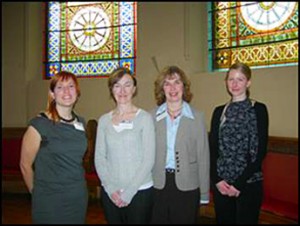 Morning Panelists, from left to right: Constance Crompton, Jo Devereux, Anne Clendinning (chair), and Jaclyn Reid. |
“Realism, Regionalism, and the Discipline”
This edition of the forum features Michael Millgate (University of Toronto) on “Hardy and Realism: A Backward Glance”, Julia Wright (Dalhousie University), who addresses interdisciplinarity in her piece “Fair Straight Lines”, and DMR Bentley (University of Western Ontario) who reflects on region and realism in “Hardy’s Wessex…”
Hardy and Realism: A Backward Glance
Michael Millgate
When I was first working on Thomas Hardy in the late 1960s his “realism” presented itself as an issue mainly in relation to his “regionalism.” That was partly because I had come to Hardy by way of William Faulkner, an even more systematic regionalist (I taught a year-long “Hardy and Faulkner” graduate course on several occasions during the 1970s and 1980s), but chiefly because the question of the “accuracy” of Hardy’s presentation of his rural characters was being quite actively debated at the time. Raymond Williams’s The Country and the City would not appear until 1973, but Douglas Brown (one of my undergraduate supervisors) had written in the mid-1950s, and later revised, an excellent study of Hardy that effectively identified “the blend of nostalgia and imaginative vision” he saw as fundamental to Hardy’s representations of the rural world that was his native Wessex . But while that went some way towards bridging what had long been the standard division between those who viewed Hardy as sentimentally yearning for an irrecoverable past and those who saw him (especially in Tess and Jude ) as a class-conscious proto-modernist, it did not altogether meet the objection that Hardy’s claims as an authentic regionalist were compromised by his failure to confront at all directly the plight of the agricultural labourer.
Hardy’s important essay “The Dorsetshire Labourer” (1883) is sympathetic to the labourer’s situation, welcomes recent economic improvements in his lot, and supports his right to a vote, while within the novels themselves phases of the labourer’s constricted and burdened life are of course sharply, painfully, and memorably presented: Marty South cutting spars; Tess on the threshing machine; Jude scaring birds; the hiring fair in Far from the Madding Crowd . On the other hand, it is certainly the case that his central characters consistently belong – either by birth (as was Hardy’s own situation) or by early transition – to an at least marginally superior socio-economic class. Accusations of class bias and regional misrepresentation may still recur, but it’s necessary to take into account Hardy’s heavy financial dependence – before the royalty system became standard – upon the sale of his work for serialization in the weekly and monthly magazines that dominated the fiction market throughout the Victorian period. Because the readership for such serials (as for the three-decker novels subsequently available from the great circulating libraries) was overwhelmingly urban, it preferred to encounter the rural world on scenic and nostalgic rather than on socio-political terms. And while transitions from one class to another could readily supply a novelist with rich narrative material, the minimal and essentially unchanging conditions of an agricultural labourer’s life clearly could not. Deeply, therefore, as Hardy cared about all aspects of the rural world to which he belonged, and steadily as he moved towards greater realism in his later novels, he must have believed that to go significantly further in that direction could result in the termination of his entire career as a novelist. As Jude the Obscure might be said to have proved.
Julia M. Wright
As we approach the thirtieth anniversary of Lyotard’s The Postmodern Condition, originally submitted as a “Report on Knowledge” to the Quebec government, it might be a good time to pause and consider the shape of disciplinarity and interdisciplinarity in (or after?) “the age of delegitimation and its hurried empiricism” (Lyotard 52).
We have chipped if not broken many of the barriers between traditional disciplines. Literary study now perhaps requires the study of history, though where context ends and historical analysis begins remains a vexed and largely unexplored question. Through the advent of Birmingham-school cultural studies, the lines between sociology and literary analysis have been similarly blurred in some areas of study, particularly in relation to material culture. And, since the 1970s, we have organized a selective canon of materials from other disciplines (philosophy, psychoanalysis, semiotics, political science) under our own heading of “theory.” While synecdochal – Freud and Lacan for psychoanalysis, rarely recent scholars; Anderson’s Imagined Communities for nationalism, but rarely Anderson’s other books or work by Ernest Gellner, Anthony D. Smith, or Tom Nairn – this canon gives us a corpus of theory that serves as a shared framework within which we can explore such questions as subjectivity and ideology, in addition to form and rhetoric. We have also annexed other media, particularly film, and are expanding beyond the boundaries of the nation-state to consider larger cultural domains, including the transatlantic, the diasporic, and the colonial.
This kind of disciplinary cosmopolitanism is not entirely new to literary studies, where the capacious category of “letters” has traditionally given us considerable license to roam freely through the library. What is more striking is the degree to which we have retreated behind the lines that divide our own traditional materials of study even as we have opened up myriad theoretical and archival avenues into “non-literary” domains. It’s becoming common to remark on the partition in Victorian studies between poetry and the realist novel, with the gothic and other poorer literary cousins, in some circles, being shuffled off to the side. But are these countervailing sea-changes in our discipline related?
Does interdisciplinarity necessitate single-genre scholarship? Or are we reading poetry and fiction differently because of interdisciplinary theory? Have some branches of interdisciplinarity (or theory) generated a new kind of formalism, reinstating generic categories on other grounds? Take, for instance, the now-waning dominance of psychoanalytic approaches in gothic studies: for a while, it was difficult to separate the mode from that theoretical frame, and the psychoanalytic approach arguably contributed to an emphasis on character development and plot that was amenable to the genre of the novel, obscuring the ways in which the gothic mode reaches into drama and verse as well. What do we lose as a discipline when we divide literary-cultural history into prose and “fair straight lines, with a capital at the beginning of each” (Scott 60)? If genre is an interdiction, as Jacques Derrida argued in the same year as Lyotard’s “Report,” what are we refusing to sanction and what are we forbidding ourselves?
Works Cited
Derrida, Jacques. “The Law of Genre.” 1979. Trans. Avital Ronell. Acts of Literature . Ed. David Attridge. New York : Routledge, 1992. 221-52.
Lyotard, Jean-François. The Postmodern Condition: A Report on Knowledge . 1979. Trans. Geoff Bennington and Brian Massumi. Minneapolis : U of Minnesota P, 1984.
Scott, Walter. Waverley ; Or, ‘Tis Sixty Years Since . 1814. Ed. Andrew Hook. Markham : Penguin, 1985.
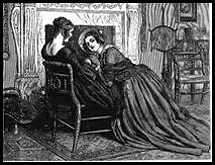 Illustration by Robert Barnes for Thomas Hardy’s The Mayor of Casterbridge , which appeared in The Graphic , 13 March 1886. Illustration by Robert Barnes for Thomas Hardy’s The Mayor of Casterbridge , which appeared in The Graphic , 13 March 1886. |
D.M.R. Bentley
Hardy’s Wessex, Dickens’s London, Wordsworth’s Lake District . . . Such phrases refer, of course, to the depiction of the region named in the work of the given author, but they also bring with them a sense of possession. By virtue of a vivid and comprehensive treatment of a chosen place, an author takes literary ownership of it and – to adapt and conflate the well-known statements of Locke and Hume regarding the nature of rights in land – “removes[s] it from the common state Nature placed it in” and “appropriates” or “annex[es] it to him[self] by the relationship of property.” In the United States, Canada, and, no doubt, other settler colonies, the notion of authorial ownership of a region or place was especially compelling for the obvious reason that vast areas were seen as awaiting literary possession and authors were keen to acquire the capital and status of literary land owners. Emerson would even go so far as to say that imaginative ownership of land transcends legal ownership:
Miller owns this field, Locke that, and Manning the woodland beyond. But none of them owns the landscape. There is a property in the horizon which no man has but he whose eye can integrate all the parts, that is, the poet. This is the best part of these men’s farms, yet to this their warranty deeds give no title.
The Canadian poet Archibald Lampman was less legalistic in “The Poet’s Possession” (1895): cautioning the “Master of the well-tilled field” against the folly of thinking that his land belongs to him alone, he envisages the poet as conjuring from the soil an “after-yield, / A second harvest … / … of images and curious thoughts.”
While the claims of Emerson and Lampman are largely fanciful and innocuous, literary acquisition or annexation bears an obvious relation to the land grabs and extirpatory practices of imperialism and nationalism. Abundant evidence of this can be found in late nineteenth- and early twentieth-century Canada , a nation characterized by W.D. Lighthall in his Introduction to Songs of the Great Dominion(1889) as “the Empire’s completest type” and “Imperial in herself.” By means of “Tantramar Revisited” (1884) and other loco-descriptive poems, Charles G.D. Roberts effectively wrested possession of Acadia (or the “ Land of Evangeline ” as it was widely known) from Longfellow and placed it under his own (Canadian) name. “For another to sing of Tantramar would be almost plagiarism,” remarked Pauline Johnson in 1896; “[t]he great Maritime marsh is not only his lyrical possession, it is himself .” In the wake of the rebellion that bears its name, the Canadian Northwest furnished Gilbert Parker with “good hunting, only to be equaled in . . . Kipling’s India,” enthused Roberts’s cousin Bliss Carman of Parker’sPierre and His People (1892). “[W]hat Pierre did,” Parker himself averred in the 1912 “Imperial Edition” of his Works , “was to open up a field which had not been opened before, but which other authors have exploited since with success and distinction.” “[L]yrical possession,” “open[ing] up a field,” and similar phrases in post-Confederation literary discourse trope Canadian poets and fiction writers as colonizers and suggest that their attitudes and achievements would well reward study in this light.
Works Cited
Adams, John Coldwell. Seated with the Mighty: a Biography of Sir Gilbert Parker . Ottawa : Borealis, 1979.
Emerson, Ralph Waldo. Selected Prose and Poetry . Ed. Reginald L. Cook. New York : Holt, Rinehart and Wilson, 1950.
Hume, David. An Enquiry Concerning the Principles of Morals . Ed. Charles W. Handel. Indianapolis : Liberal Arts, 1957.
Johnson, E. Pauline. “The Singer of Tantramar,” Massey’s Magazine 1.1 (Jan 1896): 15-19.
Lampman, Archibald. Poems . Ed. Duncan Campbell Scott. Toronto : George W. Morang, 1900.
Lighthall, W. D., ed. Songs of the Great Dominion: Voices from the Forests and Waters, the Settlements and Cities of Canada . London : Walter Scott, 1889.
Locke, John. Two Treatises of Government . Ed. Thomas I. Cook. New York : Hafner, 1965.
Parker, Gilbert. Works. 23 vols. New York : Charles Scribner’s Sons, 1912-13.
Panels of Interest to Victorianists at the Upcoming Congress
Following is a summary of some of the panels at this year’s Congress ( University of Saskatchewan , 26 May to 2 June 2007) that might be of interest to VSAO members. The VSAO panel is on Monday 28 May at 10:30 am. The panels mentioned here all focus primarily on Victorian studies, but there are Individual Victorianist papers in other panels as well. Check the final program for the full listings. To get a full sense of the diversity of offerings, check the Congress website:http://www.fedcan.ca/congress2007/programs/call_for_papers.php
Abbreviations:
ACTR – Association for Canadian Theatre Research
ACCUTE – Association of Canadian College and University Teachers of English
CASBC – Canadian Association for Studies in Book Culture
CHA – Canadian Historical Association
CLSG – Christianity and Literature Study Group
CSHPS – Canadian Society for the History and Philosophy of Science
CSHM – Canadian Society for the History of Medicine
CSCH – Canadian Society of Church History
Note: To reduce clutter and save space the names of Organizers, Chairs and Commentators have been omitted.
Saturday 26 May, 2007
5:00 P.M. — 7:00 p.m .
CLSG
Christianity and Literature Study Group
Room: Comm 3
D.M.R. Bentley (Western):“The Mouth-to-Mouth Kiss and Its Implications in the Works of Dante Gabriel Rossetti and Beyond”
Roxanne Harde ( Alberta ): “If you are one of ‘the hands’“: Discipleship and Labor Reform in the Work of Elizabeth Stuart Phelps”
Natasha Duquette ( Taylor ): “‘Sublime Repose’: The Spiritual Aesthetics of Landscape in Austen”
Katherine M. Quinsey ( Windsor ): “Better Fortitude? Gender and Christian Heroism in Milton and Dryden”
Sunday 27 May, 2007
8:30 a.m. – 10:00 a.m
ACTR
Bridging Imperial and Colonial Performance in Time: The 19th Century
Room: Arch 124
Joseph, Maia and Jerry Wasserman (UBC): Searching for Captain McDonald’s Trained Indians, “The Best Drilled People in the World”
Salter, Denis (McGill): Part One: Speaking, Embodying, Sounding, and Extirpating the Very Depths of Evil: The Theatrical Language of Henry Irving and Ellen Terry’s 1888 Macbeth
Sperdakos, Paula ( Toronto ): Ida Van Cortland and the 1877-78 Season of Mrs. Morrison’s Grand Opera House, Toronto
2:00 p.m. – 3:15 p.m.
ACCUTE/VSAWC
Size Matters I: Taking the Measure of Bodies and Books
Room: Arts 208
Michael Tavel Clarke ( Calgary ): The Height of Civilization: Victorian Science and the Management of Stature
Ryan Stephenson ( Ottawa ): Desultory Reading in the “Overgrown Jungle of Information”: Frederic Harrison, George Gissing, and the Threats to Victorian Knowledge
Lisa Surridge & Mary Elizabeth Leighton ( Victoria ): Great Expectations: Pregnancy, Illustration, and Serial Reading in Wilkie Collins’s The Law and the Lady
3:30 p.m. – 4:45 p.m.
ACCUTE/IGA
Gothic Literature and Memento Mori
Room: Arts 210
Evert Jan van Leeuwen ( Leiden , Nijmegen ): Memento Mori – Remember You Will Live: Spiritual Ecstasy and Material Resurrection in Eighteenth-Century Graveyard Poetry
Bruce Wyse (Waterloo/Laurier): “Corruption” and “the Universal Friend”: Early Victorian Visionary Variants of the Memento Mori Tradition
Heather Jones ( North Atlantic ): The Memento Mori and the Death of Aesthetic Certainty: Tim Burton’s Batman as Postmodern Parody
Monday 28 May, 2007
8:30 a.m. – 10:00 a.m
CSCH
Nineteenth-century Explorations
Room: TBA
Todd Webb (Laurentian): The Destruction of Robert Alder: An Example of Transatlantic Culture and Anarchy among the Methodists
Arlette Zinck (King’s University College): Reverend James Evans and the Hudson Bay Company: How a Cree Translation of John Bunyan’s Pilgrim’s Progress may Shed New Light on an Old Scandal
James Robertson ( McMaster Divinity College ): His Dominion vs. New Ireland: The Ontario Protestant Response to the Fenian Invasion of 1866
9:00 a.m. – 10:15 a.m. (Room: Comm 243)
ACCUTE
Writing Women
Janice Schroeder (Carleton): Darwin ‘s Feminist Bulldog?
Patricia Rigg ( Acadia ): Aestheticizing the Maternal: Augusta Webster’s Mother and Daughter and the “upheaval” of Late Nineteenth-Century Feminism
Goldie Morgentaler ( Lethbridge ): Mrs Gamp, Mrs Harris and Mr Dickens: Creativity and the Divided Self
10:30 a.m. – 11:45 p.m. (Room: Arts 208)
ACCUTE/VSAO
Victorian Virtual Realities
Ruth Knechtel ( York ): New Women and Hypermedia Realities – What We Can Learn from Egerton and Schreiner
Jennifer L. Blair (Rutgers): “For the sake of an eventuality that might never occur”: Designing North America ‘s First Fire Escapes
Julia Mamolo ( Waterloo ): Photographic Un/Realities: Representations of Photography, 1839 to 1855
10:45 a.m. – 12:15 p.m.
Craftworkers, les pharmaciens, and les arrimeurs
Room: COMM 12
Robert B. Kristofferson (Laurier): Craftsworker Self-Improvement in Mid-Nineteenth Century Ontario : The Diaries of Andrew McIlwraith
Stéphanie Tésio, (Université Laval): Exemple de transmission du savoir : les pharmaciens au XVIIIe siècle
10:45 a.m. – 12:15 p.m.
CHA
Indigenous Peoples and Christianity
Room: COMM 16
Susan Neylan (Laurier): Aboriginal Missionaries, Spiritual Borderlands: Cultural Exchange on the Northwest Coast
Derek Whitehouse-Strong ( Grant MacEwan College ): Institutions and Empire: The Shifting Dynamics Behind the Identity and Relationships of CMS Native Agents in 19th Century Canada
Tolly Bradford ( Alberta ): ‘Valuable Information’: Indigenous Missionaries and British Mission Networks
Tuesday 29 May, 2007
9:00 a.m. – 10:15 a.m.
ACCUTE/NAVSA
Size Matters II: The Management of Growth
Room: Arts 210
James Buzard (MIT): The Mid-Victorian Drama of Management
Juliette Atkinson (UC London): Appreciable Magnitude or Little Morsels of Oddity: Size and Proportion in the Dictionary of National Biography
Grace Kehler (McMaster): The Technological Sublime versus the Industrial Gothic
9:00 a.m. – 10:30 a.m.
CHA
Women, Property, and Labour in Louisiana , Tennessee , and Lower Canada
Room: COMM 116
Sara Sundberg (Central Missouri): Under Her Authority: Women and Property in Early Louisiana
Jan Noel ( Toronto ): Discrediting Dowagers in Lower Canada
Nelson Ouellet ( Moncton ): The War on Dependency in Tennessee during Reconstruction (1865-1869)
9:00 a.m. – 11:00 a.m.
CSHPS
Issues in Nineteenth Century Science
Room: Physic 130
Elizabeth Neswald (Brock): “The Benefits of a Mechanics’ Institute and the Blessings of Temperance”. Science and Temperance in mid-nineteenth century Ireland
Ian Hesketh ( British Columbia ): “It is history itself that speaks”: Aperspectival Objectivity and the Science of History in Victorian Britain
Kathleen Okruhlik ( Western Ontario ): The Traffic between Epistemic and Ethical Issues in the Work of John Stuart Mill
11:00 a.m. – 12:30 p.m.
CASBC
Print Culture in Modern Britain
Room: Arts 212
Leith Davis (English, Simon Fraser): The Printer as Patriot: James Watson’s Choice Collection of Comic and Serious Scots Poems and Eighteenth-century Miscellanies
Caroline Leitch (English, Victoria): Under the Covers: The Hidden History of Women in Nineteenth Century Book Production
Vanessa Warne (English, Manitoba ): Books for Blind Readers: Print Culture and Visual Disability in Victorian Britain
2:00 p.m – 3:30 p.m
ACCUTE/NASSR
Aesthetics and Nation in Romantic Theory and Literature
Room: Arts 210
D.M.R. Bentley (Western): “Sunshine,” “Pitiless Severity,” and the “Utmost Variety”: Climate and Scenery as Determinants of National Identity and Culture in Nineteenth-Century Canada
Tilottama Rajan (Western): The Ends of Art: Hegel’s Symbolic Art and Schelling’s Historiography in The Ages of the World
Wayne C. Ripley ( Winona State University, Minnesota ): English Citizenship and Nationhood in Barbauld’s Dissenting Poetic and Politic.
Of Special Note : 3:30 p.m. to 5:30 p.m.
(ACCUTE)
Alice-in-Wonderland Celebrity Croquet Game
Delegates are welcome to join a zany re-enactment of the croquet game in chapter eight of Lewis Carroll’s classic. A benefit on behalf of READ Saskatoon and adult literacy, the game will feature appearances by Peter MacKinnon (President of the University of Saskatchewan ) and some surprise celebrities.
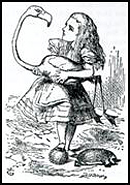 Alice playing Croquet Alice playing Croquetby John Tenniel |
WEDNESDAY 30 MAY, 2007
9:00 a.m. – 10:30 a.m.
CHA
Performativity for Historians and their Publics
Room: ARTS 263
Ariel Beaujot, ( Toronto ): Can Objects Speak? The Glove and the Performance of Middle-Class Womanhood, 1830-1920
Christopher Ernst, ( Toronto ): Performing Politics: Public Entertainment and the Construction of Political Discourse in Victorian Toronto
Kristina Guiguet, (Carleton): Mrs. Widder, is this yours? Recording an 1844 Concert Program: Performance or Creation?
FRIDAY 1 JUNE, 2007
9:00 a.m. – 10:30 a.m.
CSHM
Gender and Professional Identity
Room: HLTH B450
Chris Dooley ( Manitoba ): “Needle Nurses” and “people persons”: examining the representational strategies of male psychiatric nurses in post-war western Canada
Judith Godden ( University of Sydney ): Public Knowledge or Public Spin? Colonial Doubts about the Nightingale School of Nursing in its founding decade
Carol Helmstadter ( Toronto ): From Matron to Lady Superintendent to Matron: authority and leadership in 19th century England
SATURDAY 2 JUNE, 2007
9:00 a.m. –10:30 a.m.
CSHM
Transmitting Medical Knowledge
Room HLTH B3
Marilyn Barber ( Carlton ): Save the Mothers: The Mission of British Outpost nurses in Western Canada
Judith Young (Nurse): Nurses and Midwives in Halifax, Nova Scotia and St. John, New Brunswick 1800-1890
James Moran (UPEI): Mediating the Message: Parish Priests and St. Paul’s Bay Disease
Celebrating the 40th Anniversary of the VSAO
David Latham
In celebration of the fortieth anniversary of our annual conferences, we honoured a select group of scholars who have been members since the first decade of our association, from 1967 to 1976, as we wished to show our appreciation for the tradition of scholarship they forged for all of us to live up to. At the presentation we displayed our dog-eared seven-page Report from 1967, documenting the founding of our Victorian Studies Association, and some of the earliest newsletters, documenting such events as the first annual conference, held in March 1968 at Vanier College, York University . I then read a sentence from a more recent newsletter (March 2004) citing Isobel Armstrong’s recognition of Canadian scholarship at the forefront of Victorian studies, as she praised the “crucial part played by Canadian researchers and scholars in sustaining and advancing Victorian studies in the last three decades of the 20th anniversary.”
I wondered aloud whether our founding members ever imagined that they could create such a vibrant community of scholars; reading through those early newsletters made me realize that, yes, our founding members confidently and responsibly did indeed know what they were creating.
The following members were presented with official “Victorian Scholar” certificates: Donald Hair, Richard Landon, Trevor Lloyd, Eleanor Morgan, Paul Phillips, Ann Robson , Jill Shefrin, and William Whitla. The citation reads: “On this occasion of the fortieth annual conference of the Victorian Studies Association of Ontario, we appreciate the opportunity to acknowledge your long-term contribution to the discipline of Victorian scholarship. We thank you for encouraging a community of scholars in Canada, a community that thrives as the second oldest interdisciplinary Victorian studies association in the world, a community that we trust will continue to honour your interest in promoting the study of all aspects of Victorian culture.”

